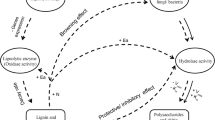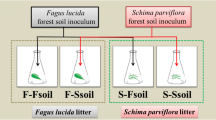Abstract
Litter bags containing sterile Scots pine (Pinus sylvestris) needles (19.8% lignin, 26.5% cellulose and 0.34% N) were inoculated with two species of fungi in the laboratory and then placed in the litter layer of a pine plantation. Marasmius androsaceus, which can degrade lignocellulose, was initially displaced by other fungal colonisers and was not detected in the litter after 2–3 months; but was re-isolated from the needles after 12 months. Trichoderma viride, which is a cellulolytic species and also antagonistic to other fungi, dominated the litter throughout the experiment. The control litter was naturally colonised by litter fungi. After 12 months, mass losses were similar at 52% for M. androsaceus and 48% for T. viride, compared with 36% for the control litter colonised by a more complex fungal community. Lignin concentrations increased with time in control litter and with T. viride because mass losses of carbohydrates were greater than those of lignin. Litter inoculated with M. androsaceus showed significant lignin decomposition throughout the experiment but cellulose concentrations showed a proportional increase in the first 6 months, suggesting that the fungus was preferentially exploiting hemicellulose and non-structural carbohydrates. Analysis of TFA-extractable sugars (mainly from hemicellulose) and CuO-derived phenylpropanoid moieties from lignin confirmed the differential patterns of resource decomposition which were not evident from total mass losses. During the initial stages of decomposition, T. viride was as effective in utilising structural polysaccharides as the complex fungal community in the control litter. Furthermore, M. androsaceus not only exhibited unexpectedly low cellulolytic activity but also facilitated lignin depolymerisation after the fungus was no longer detectable in the litter. The pre-inoculation of litter with these two fungal species therefore affected the overall dynamics of decomposition at a biochemical level. This study illustrates the importance of understanding the effects and interactions of specific fungi, rather than assumptions about the functional competence of diverse communities, on the processes of litter decomposition.
Similar content being viewed by others
Author information
Authors and Affiliations
Additional information
Received: 5 July 2000
Rights and permissions
About this article
Cite this article
Cox, P., Wilkinson, S. & Anderson, J. Effects of fungal inocula on the decomposition of lignin and structural polysaccharides in Pinus sylvestris litter. Biol Fertil Soils 33, 246–251 (2001). https://doi.org/10.1007/s003740000315
Issue Date:
DOI: https://doi.org/10.1007/s003740000315




